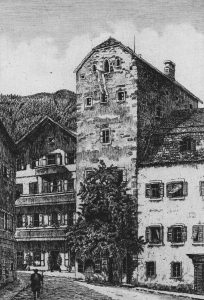
When was the Vogtturm built?
Even today we cannot say with absolute certainty when exactly, why and by whom this fortified building was erected. However, there is much to suggest that the Zell Tower was built around the middle of the 12th century on behalf of the once powerful Counts of Lechsgemünd, who administered the Pinzgau region as a royal fiefdom in the High Middle Ages.
The five-storey tower and the neighboring residence (now the Carl Spängler bank) were part of an ensemble of houses that surrounded a triangular courtyard enclosed by gates (today’s town square). The tower, originally built as a defensive (keep with a protective function), functional (control of travelers and collection of tolls) and representative building, reflected the power and influence of the Swabian-Bavarian noble family together with the count’s court and the adjacent church district surrounded by a wall (with St. Hippolyt as the count’s own monastery).
What are the special architectural features of the Vogtturm?
Located in the north-west of Zell’s town square, the 23.5-metre-high tower has a trapezoidal ground plan and an unusual height of 23.5 meters and is open on three sides. While the external dimensions on the north, south and west sides are 8.6 meters each, the tower expands to an impressive 13 meters towards the adjacent building on the east (lake side). The walls are 1.26 m thick to the north, 1.04 m thick to the south and 1.22 m thick to the west, while the east wall is up to 1.59 m thick. The unusual location in the center of the village is reminiscent of the dynastic towers of Tuscany.
The Federal Monuments Office’s appraisal of the historic building states that the Vogtturm is of historical, artistic and cultural significance. These interests are reflected in numerous details, such as the stone portals on the first floor and the elaborately crafted window walls. A special feature of the interior are the many window niches with brick seats. Their large number is extraordinary. The Vogtturm has a total of 18 such niches, nine of which are on the fourth floor. No other medieval interior in the province of Salzburg is known to have so many window niches with brick seats.
Why is the tower called “Vogtturm”?
The origin of this name is not known. In the Middle Ages, a “Vogt” was a high-ranking administrative official of a noble landlord, a diocese or a monastery. It is quite possible that there were bailiffs in Pinzgau. Therefore, the tower could theoretically have been the seat of a bailiff. However, there is no proof of this. The name “Vogtturm” has probably only been used since the 19th century. The oldest known evidence dates back to 1855.